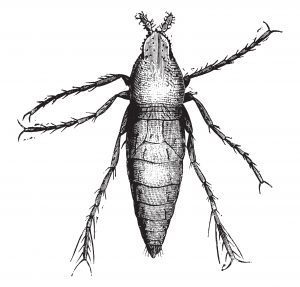Chiggers Are Not Inside Pests
By Chris Williams on August 4, 2011.
Q. Can you give me some information about chiggers? Our doctor thinks that’s what has been biting my daughter. Should I have our house treated?
A. Treating inside your home won’t have any effect on chiggers which are outside pests. Chiggers (sometimes called red bugs) are the immature larval forms of a particular mite. They are pale to red in color and smaller than the period at the end of this sentence. So small, in fact, that most people cannot see them without magnification.
Chiggers are most common outside in undeveloped, low, damp areas with thicket or scrub-type vegetation. But some species are adapted to living in drier places where vegetation is low, so heavy infestations can even occur in lawns, golf courses, and parks. They lurk on grass stems and in shrubbery waiting for an animal to pass by. Trial and error is about the only way to know whether an area is infested with chiggers; you can’t tell by looking at a site. They can be just about anywhere. Chigger numbers in any one site also can vary from year to year. They can occur in some places only for short periods, or they can remain in lawns for years. Chiggers are usually active in our area from June until the first frost and are most active in early summer when vegetation is most lush.
Clover mites and chiggers are often confused. Clover mites can invade homes, often in large numbers, at certain times of the year. Some people see the very tiny, reddish mites crawling on walls and believe they are seeing chiggers. Chiggers do not enter homes, except perhaps on the bodies of people who have been outside. And clover mites do not bite people.
Chigger bites usually occur in areas of the body where clothing is tight such as ankles, crotch and waistline, or where the skin is thin, tender, or wrinkled such as back of the knees and front of the elbow. The chigger attached its mouthparts to the host and proceeds to feed. However, chiggers don’t suck blood from their hosts. Instead, the chigger injects saliva into the skin that dissolve tissues which the chiggers then suck up.
 The bite results in a small, reddish welt with a white, hard center which may not appear until several hours later. A chigger attached in a pore or at the base of a hair may be so enveloped in swollen skin that it appears to be burrowing into the skin. This sometimes leads people to think, mistakenly, that chiggers embed themselves in the skin. If undisturbed, the chigger larva will feed for about 4 days, then it drops off to change into a nymph. Scratching often removes the chigger sooner, although the itching may continue for a week or longer. Chigger bites can cause intense itching, and many people have a more severe reaction to the bite, even resulting in fever. Chiggers are not known to transmit any diseases in the U.S.
The bite results in a small, reddish welt with a white, hard center which may not appear until several hours later. A chigger attached in a pore or at the base of a hair may be so enveloped in swollen skin that it appears to be burrowing into the skin. This sometimes leads people to think, mistakenly, that chiggers embed themselves in the skin. If undisturbed, the chigger larva will feed for about 4 days, then it drops off to change into a nymph. Scratching often removes the chigger sooner, although the itching may continue for a week or longer. Chigger bites can cause intense itching, and many people have a more severe reaction to the bite, even resulting in fever. Chiggers are not known to transmit any diseases in the U.S.
Insect repellents should be used where chiggers are a problem. Apply repellent to socks and the bottom of pants, or tuck pants into socks. A thorough, soapy bath or shower immediately after exposure may be helpful in removing the mites. It’s important to launder your clothes, too, after you’ve been in a chigger infested area. Chiggers can remain on the clothes for some time.
In severe residential infestations, lawns or portions of yards can be treated by a pest control company. If you know where the chigger infestation is located, treatment can be limited to that area, or you can just treat high-use or high-risk areas such as around swing sets or picnic tables. Clearing brush from your yard and mowing grass close will help remove cover for chiggers.
Sign up for our biweekly email newsletter for more information about bugs and pests!